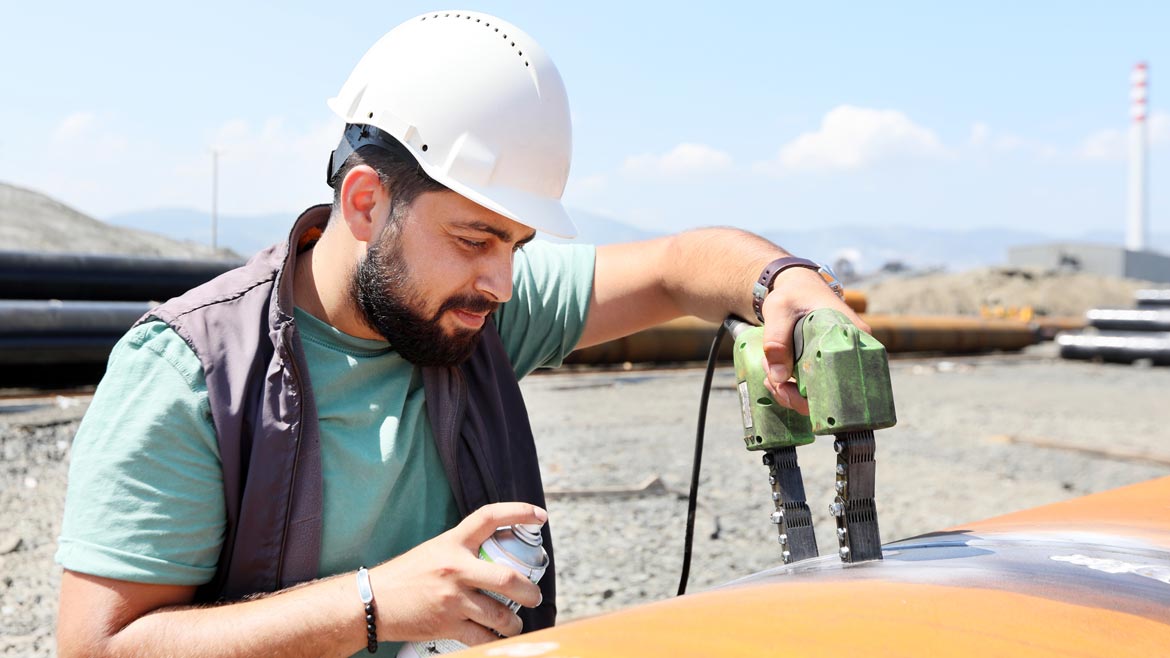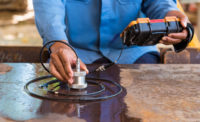First, what is an NDT training program?
Various codes and standards have varying definitions of exactly what is required for an NDT training program to be considered acceptable. In the United States, the most recognized and followed documents used as guidelines or standards for building an NDT training program are ASNT (American Society for Nondestructive Testing) SNT-TC-1A, ANSI/ASNT CP-189, and ANSI/ASNT CP-105.
The aforementioned documents follow the same “Two component” training system, which consists of formal classroom/online/theory type training, followed by OJT (on the job training or experience hours).
Let’s discuss the on the job training (OJT) portion of an NDT training program. OJT is performed most often in a field or lab setting while performing NDT examinations using various examination methods. Each NDT method of examination has its own requirement of practical OJT experience depending on the method’s difficulty. For example, liquid penetrant, being one of the most basic NDT methods, requires only 210 hours of OJT to be certified to Level II. Whereas the ultrasonic and radiographic examination methods require 840 hours of OJT to be certified to Level II. OJT experience hours are garnered and performed under the supervision of a certified NDT Level II or Level III.
Now let’s talk about the formal classroom/online/theory portion of any NDT training program.
Each NDT method of examination has its own requirement of formal classroom/online/theory hours depending on the method’s difficulty. Once again, liquid penetrant, being one of the most basic NDT methods, requires only 12 hours of formal classroom/online/theory training to be certified to Level II, and again, the ultrasonic and radiographic examination methods require 80 hours of formal classroom/online/theory to be certified to Level II.
SNT-TC-1A provides a definition of the formal classroom/online/theory portion of an NDT training program as:
“The organized training may include instructor-led training, personalized instruction, virtual instructor-led training, computer-based training, or web-based training.”
The full definition of “Training Programs” for document of SNT-TC-1a (2020) can be found in section 7.0.
ANSI/ASNT CP-189 addresses the formal classroom/online/theory portion of an NDT training with multiple definitions as follows.
“Education: An institutionalized program, prescribed by appropriate authorities, that is offered by schools, institutes, organizations, colleges, or universities established for the sole purpose of providing instruction in an orderly, planned, and systematic fashion.”
“Formal Training: An organized and documented program of activities designed to impart the knowledge and skills to be qualified to this standard. Formal training may be a mix of classroom, practical, and programmed self-instruction as approved by the responsible NDT level III.”
“Personalized Instruction: Personalized instruction may consist of blended classroom, supervised laboratory, and/or hybrid online competency-based course delivery.”
The full definitions of “Training Programs” can be found in section 2.1 of ANSI/ASNT CP-189-2020.

Image source: Getty Images
SNT-TC-1A and ANSI/ASNT CP-189 are quite different in their wording and requirements pertaining to the formal classroom/online/theory portion of an NDT training program.
The major difference is that SNT -TC-1A is a “Recommended Practice.” As a recommended practice it establishes a general framework for educational, experience, and training for the various NDT methods recognized by ASNT. This is addressed in the forward of the document with statements such as “This Recommended Practice is not intended to be used as a strict specification,” and “The verb “should” has been used throughout this document to emphasize the recommendation presented herein.” The reasoning behind the creation of SNT-TC-1A as a Recommended Practice is to allow the employer leeway when creating their NDT training and certification program.
SNT-TC-1A recognizes that the needs of each employer differ depending on the type of equipment they are performing examinations on (New construction pipeline, pipeline integrity, refinery, oil and gas, pulp paper, nuclear, above ground storage tanks, pressure vessels, or aerospace, etc.), governing codes, client’s requirements, etc.
For example, let’s say your company only performs liquid penetrant examinations. Also, your company only performs Type II, Method C liquid penetrant examinations (Visible dye, solvent removable). Type II penetrant only has one level of sensitivity and Method C, Solvent Removable penetrant, is used primarily for inspecting small localized areas. In this instance, SNT-TC-1A allows for an employer to require abbreviated training and experience hours that focus only on this type and method of liquid penetrant inspection, therefore foregoing the use of type II penetrant, as well as the other various methods of penetrant removal, as long as the employer clearly states these details and limitations in their written practice as well as provides supporting rationale for the modification of the recommendations of SNT-TC-1A.
This same principle can be applied to any of the NDT methods recognized by ASNT. As another example, let’s say your company only performs radiographic inspection on wheel hub castings utilizing an X-Ray cabinet. Would it be necessary to learn in-depth knowledge about weld discontinuities and gamma ray safety requirements? Would it be necessary to require 840 hours of on the job training, which is required for a fully trained and qualified radiography technician capable of all types of radiographic examinations? The short answer is no, but keep in mind that having well trained and capable technicians is paramount to providing a safer world through nondestructive testing.
ANSI/ASNT CP-189 is a “Standard,” therefore it does not provide the employer leeway when considering an NDT qualification and certification program. Instead, as stated in section 1.0 Scope, “This standard details the minimum training, education, and experience requirements for NDT personnel and provides criteria for documenting qualifications, and certification.”
Now that we understand the differences between formal classroom/online/theory and the OJT portions of an NDT training program, let’s discuss how we decide what topics must be taught in a comprehensive NDT training program. For this, we look to the document ANSI/ASNT CP-105 Topical Outlines for Qualification of Nondestructive testing Personnel.
This detailed document has been compiled to establish the minimum topical outline requirements for the qualification of nondestructive testing personnel for levels I, II, and III. For example, in magnetic particle testing, the first five major sections are as follows: 1.0 Principles of magnets and magnetic fields, 2.0 Characteristics of magnetic fields, 3.0 Effects of discontinuities of materials, 4.0 Magnetization by means of electric current, 5.0 Selecting the proper method of magnetization. ANSI/ASNT CP-105 is another important and useful document to be considered when creating an NDT training program.
In closing, there are many variables to consider when creating an NDT training program, but the most important question to be asked is, “Is this training program sufficient to prepare a technician to perform critical examinations in the field of nondestructive testing?” If the answer is yes, then you are ready to bring this knowledge to your students to prepare them for a rewarding career.
REFERENCES
ANSI/ASNT CP-105-2020, Topical Outlines for Qualification of Nondestructive Testing Personnel, 2020 Edition
SNT-TC-1A, Personnel Qualification and Certification in Nondestructive Testing, 2020 Edition
ANSI/ASNT CP-189-2020, ASNT Standard for Qualification and Certification of Nondestructive Testing Personnel, 2020 Edition
2012 Edition NAS 410, NAS Certification and Qualification of Nondestructive Testing Personnel, 2014 Edition



